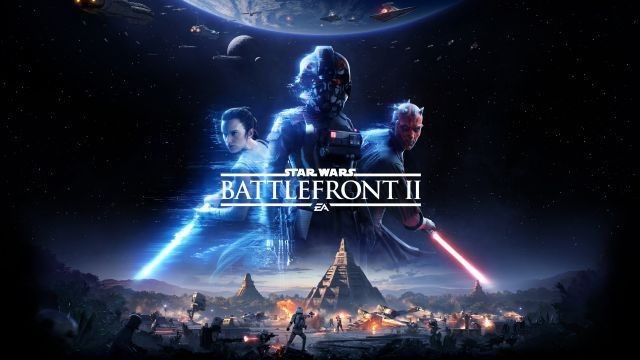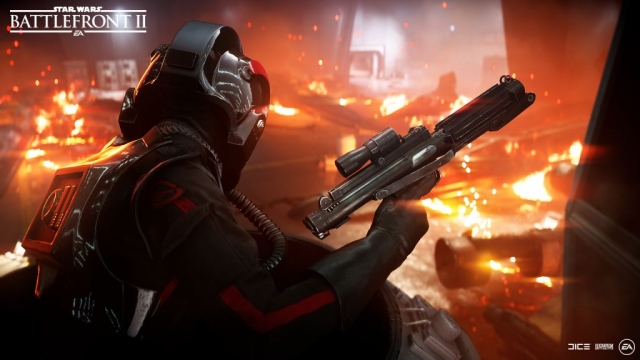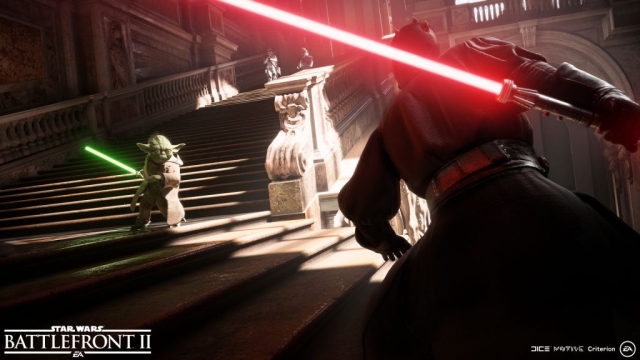Star Wars Battlefront II

The Good: Authentic Star War-zy graphics and sound. Some really nice cameos in the campaign.
The Bad: Campaign is short and narratively awkward.
The Ugly: Ridiculously imbalanced multiplayer games.
I should probably begin by saying that, as a rule, I try and avoid reading any reviews or engaging with other gamers or looking at forums where I might come across game comments which could influence my review. In the early days of gaming, this was pretty easy. You had to actually go to the trouble of connecting to the interwebs with a dial up modem to actively seek out other gamer opinions. Today, it’s tougher. Simply avoiding game review sites is no longer good enough. Game reviews are everywhere on even regular news sites, often with spoiler-y, unclever headlines like “New Star Wars game fails to use the force” (Thank you, CNN.com). I also have a lot of friends who are gamers, who send me quick chat comments like “The nu Star Wars game sux donkey ballz!!!” even if I ask them not to. In a related note, wow, my friends cannot spell. Battlefront 2 has further complicated my life by allowing players to purchase upgrades either through an apparently stupendous amount of grinding or with real world money. That last bit about the real world money naturally resulted in howls about players paying to win, providing a new layer of inequality to an existence that perhaps has enough income inequality built into it already. There was also something about loot crates maybe (or maybe not) providing powerful upgrades, which (again due to the real world money thing) resulted in the Belgian (or maybe Brazilian, or perhaps Belarusian – one of those ‘B’ countries) government to declare it unregulated gambling. To EA’s credit, they have been quick to respond to such complaints, both reducing the amount of grinding necessary to get the best upgrades and removing the entire real world money side of the game, though they say (warn) that they will be bringing it back at some point in the unspecified future. To their detriment, they somehow felt that $60 for a game was not enough; that they wanted to also fleece gamers with a universe of microtransactions (some of which were not very micro) – an accusation that has been levied against EA in the past if I’m not mistaken. The very thing I mentioned fearing in my most recent Call of Duty game review, and EA has already gone and done it. So my best-laid plan of avoiding any press about Star Wars Battlefront 2 was wrecked before I even got the game installed on my hard drive, and that press was not kind, and I can’t uncook that egg (or put that toothpaste back into the tube, or whatever home-spun homily you would care to apply) and put my brain back into a state before I had heard everything I’ve heard about the game. I’ll finally add that I’m over 500 words into this review, and have yet to mention one word about how the game actually plays. Yay, word count. Let’s start fixing that right now.
Unlike the previous Battlefront, SW:BF2 has a single player campaign. As an old timey gamer, I’m fascinated by the way games were all about the single player campaign way back when, but then gradually the single player campaigns were phased out in favor of multiplayer, at one point resulting in a number of games with little or no single player content at all, and now it seems to be phasing back in again. SW:BF2 has a campaign; what begins as a glorious campaign. The campaign in SW:BF2 has very high production values – great graphics and music and voice work, like you’re watching and playing in a Star Wars movie. Its storyline weaves really nicely around pivotal moments from Return of the Jedi and feeds into the new movies. You play primarily as Ideo Versio, a member of an elite Empire infiltration/assassination/problem solving team known as the Inferno Squad. The point of view of soldiers of the Empire, that the Rebellion is made up of terrorists and anarchists and a bunch of other unlikeable rabble while the Empire stands for stability and peace, is nicely narrated. The somewhat predictable change of heart of your character and some of her squadmates is considerably less well justified (in one case amounting to essentially, ‘Luke Skywalker is such a nice guy – maybe I’m on the wrong side of this conflict’), which gives the campaign a very abrupt and unsatisfying feeling, made all the more awkward because it started out so well. You get to take part (peripherally) in a number of the most pivotal battles of the movies, and there are some really great and surprising cameos (What has Billy Dee Williams been up to all these years?), some of which you get to play. A chance to step into Luke’s shoes gives you a taste of force powers (force push, and a kind of kinetic ground blast area effect), and it’s just awesome to grind through a pack of stormtroopers, light sabering some, hurling others off cliffs. Luke also has a kind of high sidekick attack that plants a boot right into an enemy chest plate. This is then followed by a whole sequence in which Luke is fighting bugs – big bugs, say schnauzer sized – and all of his attacks look ridiculous. His kicks and light saber swings are both into the air high above the bugs. Sometimes they hit, sometimes they don’t. I did a lot of the ground kinetic attacks. I’m just saying it looks very silly.
Beyond the somewhat short, very linear, and probably not replayable single player campaign, most people coming to Battlefront 2 are going to be interested in the multiplayer. This has proven to be very difficult to review, because there have been so many game updates to multiplayer since the release that I feel like I’m trying to review a moving target, though the core of multiplayer has not changed all that much through the updates. Players can choose one of four loadouts – assault, heavy, specialist (sniper) and commander – though they can switch loadout any time they are killed. There are five game variants: Blast (standard team deathmatch), Heroes vs. Villains (4 v 4 team deathmatch), Starfighter Assault (objective-based combat in space), Strike (short, objective-based combat), and Galactic Assault (objective-based combat on air and ground). If you’re confused as to the difference between Strike and Galactic Assault, it seems to be the number of objective the teams are trying to accomplish. Far and away, most people are playing Galactic Assault, which remains the coolest variant from Battlefront 1. Players are tasked with escorting a walker, stealing intel, rescuing prisoners, sabotaging installations and the like. The maps are big and beautifully rendered. So many people are playing Galactic Assault that I had to wait a pretty long time for a Starfighter Assault or Strike game to start while the server scraped together sufficient players.
Long story short, the multiplayer gaming is staggeringly unbalanced because of the way the whole game is structured, and I doubt even another dozen updates is going to change that. During a player’s career, they earn (and at one time bought with cash) credits, which could be used to buy star cards. Star cards are purchased randomly in crates and can be anything from nearly useless to staggeringly powerful. Combined with this is a level progression in which players get to use one star card up to level 5, two from levels 5 to 10, and three above level ten. A player who has accumulated a lot of particularly powerful star cards, using three of them, is brutal, but it gets even worse. In the game, players are awarded points for kills or accomplishments as part of the objectives, and these points are used to get reinforcements, allowing players to join the game as powerful characters – death troopers, advanced droids, jet-pack soldiers, vehicle drivers, and (if you have spent credits to unlock them) a pivotal character like Darth Vader, Luke Skywalker, Han, Leia, and characters from the new movies. Initially these character unlocks cost a fortune, over a hundred thousand credits, and for about 10 hours of play I have maybe 25,000 credits to show for it. One of the early game updates brought that price into the 10,000-25,000 range, so I could afford to unlock them if I choose. But, and here’s a pretty big but, unless I’m already doing very well in multiplayer, I’m not going to earn enough points to call them as reinforcements. So how it plays is one player, amped up on star cards dominates the game, and then is awarded a reinforcement like Darth Vader, and dominates even more. When Darth Vader hits the battlefield, pretty much everyone on the opposing team is screwed, unless you’ve got a hero on your side as well, in which case it turns into something like a 1v1 hero battle with everyone else acting as cannon fodder. I played Galactic Assault for three or four hours in a run, and the same couple of players dominated the game and came in first or second place every single time. When I come face to face with another player, and they’re just better than me, I’m OK with that. When I’m beaten because they’ve got a better weapon, more health, and a better shield (things I might not get in another 10 hours of playing), I’m not OK with that. I’ll add, to heap indignity upon indignity, the game seems to do nothing to balance the teams. I’ve seen games where the worst player on one team massively outscored the best player on the opposing team – just a completely lopsided match – and you think the game taking into account star cards and player levels could fix that. In small games, like Strike and Blast, the lopsidedness can end a game in minutes, so at least the pain is over quickly. On larger Galactic Assault maps, the multiple objectives can dilute the single player dominance effect, at least somewhat.
Back in the early days of simple multiplayer deathmatch FPS (and coal-fired computers), each match more or less stood on its own. There might be bragging rights on some grand leaderboard somewhere, but for the most parts players were only as good as their last game. Then games started to reward those people who played a lot with bonuses, initially for the most part cosmetic, but later with improved weapons and stats. We seem, unfortunately in my opinion, to have hit a new apex in which the people who play a lot gain such tremendous play bonuses that the casual player, even the exceptional casual player, no longer stands a sporting chance – and I say this as a guy who plays games an above average amount, so often I end up as one of those guys with the better stuff. Evolutionarily speaking, it’s only natural that game companies would choose to monetize that stuff, allowing players who either are not very good or simply patient enough to play and earn those bonuses to buy them. This trend results in such a skewed and unfair gaming experience, that many players, certainly the most casual players, will quickly become alienated, leaving a thin slice of such elite or pathologically dedicated or stupidly wealthy gamers. I strongly suspect that is where Star Wars Battlefront II is headed, no matter how many updates are made.
Reviewed By: Phil Soletsky
Publisher: Electronic Arts
Rating: 65%
——————————————————————————–
This review is based on a digital copy of Star Wars Battlefront II for the PC provided by Electronic Arts.
 Game Over Online
Game Over Online








